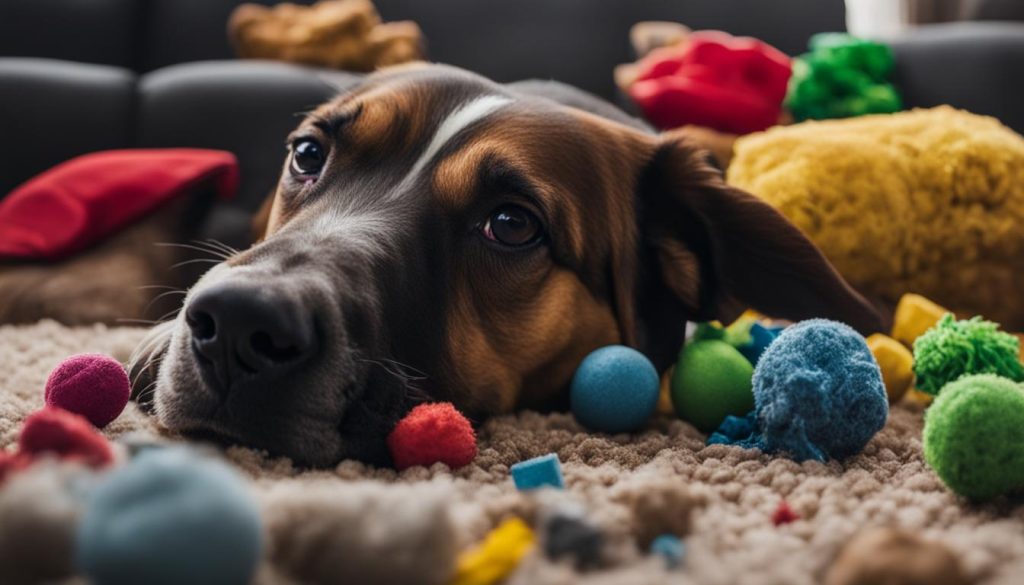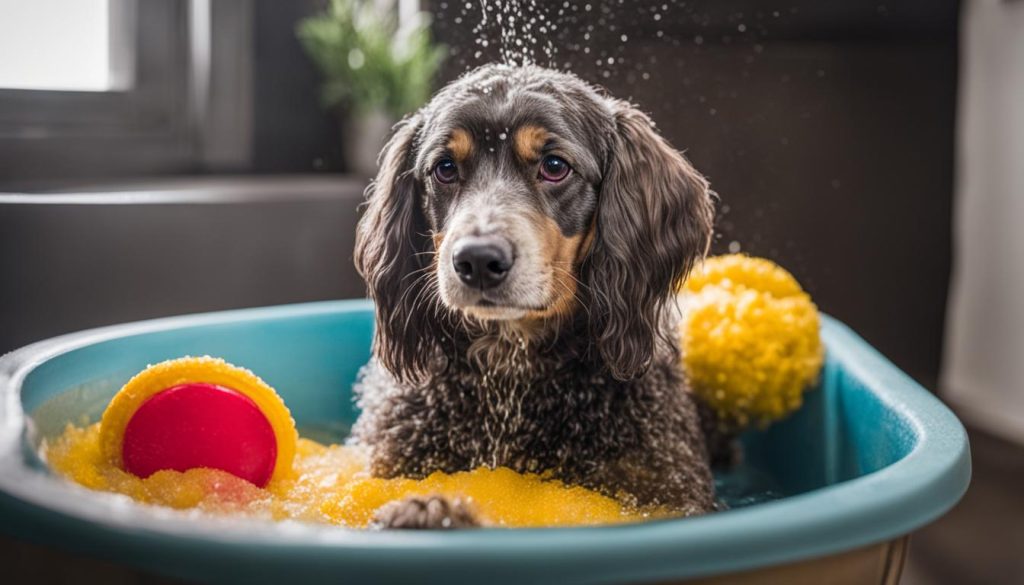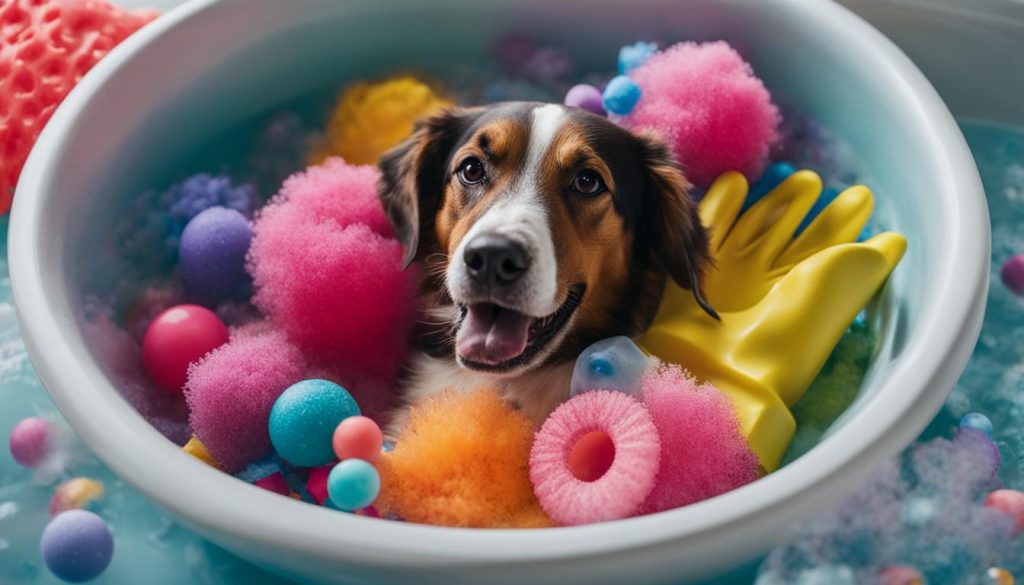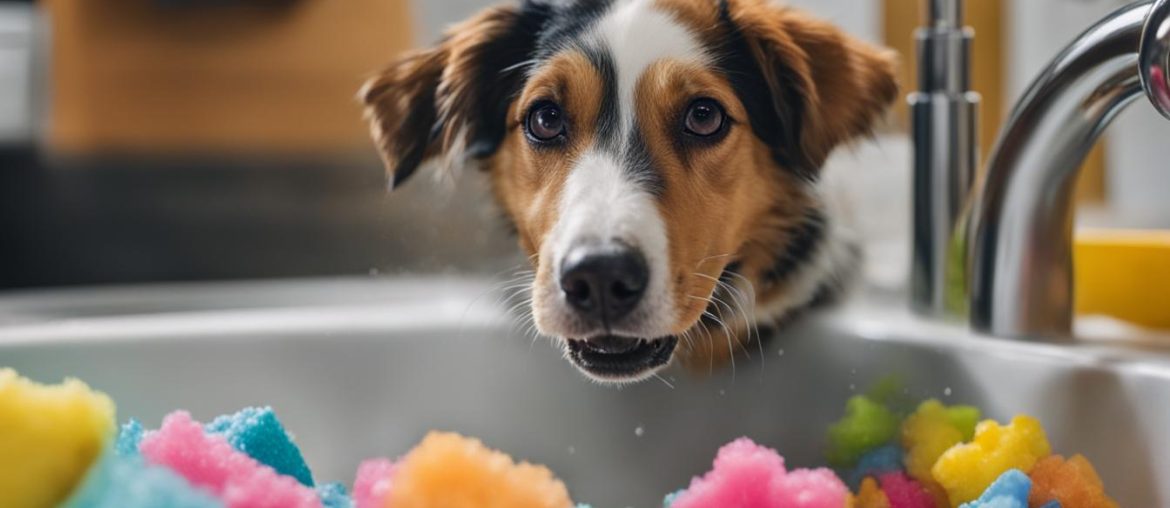Most dogs have a favorite toy that they carry everywhere, but these toys can actually harbor harmful bacteria and contaminants. Regular cleaning of dog toys is essential to protect both your pet and your family from potential health risks. In this article, I will guide you through simple and effective steps to wash dog toys at home. These cleaning methods apply to a variety of toy materials, including plush, rubber, nylon, and rope.
Key Takeaways:
- Regularly clean your dog’s toys to prevent the spread of bacteria and germs.
- Different types of dog toys require different cleaning methods.
- Plush toys can be washed in the washing machine or hand-washed.
- Rubber, nylon, and plastic toys can be scrubbed and soaked in warm, soapy water.
- Rope toys can be washed in the washing machine or sanitized in warm water and the microwave.
- Disinfecting and sanitizing dog toys is important to eliminate bacteria and viruses.
- Consider using natural cleaning methods for eco-friendly and non-toxic toy cleaning.
Why You Should Clean Your Dog’s Toys

To ensure the health and well-being of your furry friend, it is essential to regularly clean your dog’s toys. Dirty toys can harbor harmful bacteria and germs, posing a risk to both your pet and your family. Dogs love to slobber and chew on their toys, and this can transfer contaminants to their mouths, potentially leading to illness. Additionally, dirty toys can attract dust mites, which can cause allergies in dogs.
Regular cleaning of your dog’s toys helps prevent the spread of disease and keeps your pet safe and healthy. By removing dirt, bacteria, and other pathogens from their toys, you can create a clean and hygienic environment for your furry friend. Cleaning your dog’s toys is an essential part of responsible pet ownership and ensures that your dog can enjoy their playtime without any health risks.
The Health Risks of Dirty Dog Toys
Dirty dog toys can carry a variety of health risks for both your pet and your family. Bacteria and germs can thrive on the surface of toys, especially if they are frequently exposed to dirt, saliva, or fecal matter. When your dog chews or plays with these toys, they can ingest these harmful pathogens, leading to gastrointestinal issues, infections, or other health problems.
“Regular cleaning of your dog’s toys is crucial to prevent the transmission of bacteria and keep your pet healthy.”
Children are particularly vulnerable to the germs on dog toys, as they often interact closely with their furry friends. By cleaning your dog’s toys regularly, you can minimize the risk of your family members getting sick or experiencing allergic reactions caused by the buildup of dirt, dust, or allergens on the toys.
How Often Should You Clean Dog Toys?
Cleaning your dog’s toys regularly is essential to maintain their hygiene and prevent the spread of bacteria and germs. The frequency of cleaning depends on various factors, including how often your dog plays with the toys, where they play with them, and the type of toy. Generally, it is recommended to clean dog toys at least once a month.
If your dog frequently plays with their toys outside or in dirty environments, it is advisable to clean them more often. Toys that come into contact with fecal matter should be cleaned and disinfected immediately. By practicing regular cleaning, you can ensure the toys remain safe and free from harmful contaminants.
To help you keep track of your cleaning routine, here is a recommended cleaning schedule for different types of dog toys:
| Toy Type | Recommended Cleaning Frequency |
|---|---|
| Plush Toys | Once every 2-4 weeks |
| Rubber, Nylon, and Plastic Toys | Once every 2-4 weeks |
| Rope Toys | Once every 2-4 weeks |
Remember, these are general guidelines, and you should adjust the cleaning frequency based on your dog’s habits and the condition of the toys. Regular cleaning will help ensure a healthy and hygienic playtime for your furry friend.
How to Clean Plush Dog Toys

Plush dog toys are beloved by many dogs for their softness and cuddliness. However, over time, these toys can accumulate dirt, dust, and even bacteria, putting your furry friend’s health at risk. Regular cleaning of plush dog toys is essential to maintain their cleanliness and hygiene. Here are some effective steps to clean and care for your plush dog toys:
- Remove visible dirt: Start by removing any visible dirt or debris from the toy’s surface. Use a toothbrush or comb to gently brush away loose dirt or hair. This step will help prepare the toy for a deeper clean.
- Machine wash on a gentle cycle: If the plush toy is machine washable, place it in a mesh laundry bag to protect it during the wash. Use a pet-safe detergent and set the machine to a gentle or delicate cycle. Avoid using fabric softeners or bleach, as these can damage the toy’s material. Wash the toy with similar colors to prevent color bleeding.
- Hand-wash for delicate toys: For delicate or non-machine washable plush toys, hand-washing is the best option. Fill a basin or sink with warm water and add a small amount of pet-safe detergent. Soak the toy in the soapy water for a few minutes, then gently scrub it with a soft brush or sponge. Pay extra attention to any stains or spots on the toy. Rinse thoroughly with clean water to remove all traces of detergent.
- Drying the toy: After cleaning, it’s important to dry the plush toy thoroughly to prevent mold or mildew growth. Squeeze out excess water without twisting or wringing the toy. Place the toy on a clean towel and gently press to remove more moisture. Let the toy air dry completely in a well-ventilated area. Avoid exposing it to direct sunlight or high heat, as this can damage the toy’s material.
Cleaning plush dog toys regularly will help keep them fresh, free from dirt, and safe for your furry friend to enjoy. Always check the toy’s label for specific care instructions, as some toys may have additional requirements or limitations.
Table: Recommended Cleaning Methods for Plush Dog Toys
| Cleaning Step | Description |
|---|---|
| Remove visible dirt | Use a toothbrush or comb to gently brush away loose dirt or hair from the toy’s surface. |
| Machine wash on a gentle cycle | Place the plush toy in a mesh laundry bag and wash it with a pet-safe detergent on a gentle or delicate cycle in the washing machine. |
| Hand-wash for delicate toys | Soak the toy in warm, soapy water and scrub it gently with a soft brush or sponge. Rinse thoroughly to remove all traces of detergent. |
| Drying the toy | Squeeze out excess water, place the toy on a clean towel, and let it air dry completely away from direct sunlight or heat. |
By following these cleaning methods, you can ensure that your plush dog toys remain clean, fresh, and safe for your furry friend to enjoy.
How to Clean Rubber, Nylon & Plastic Dog Toys

When it comes to cleaning rubber, nylon, and plastic dog toys, the process is relatively straightforward. Start by scrubbing off any visible dirt or debris using a toothbrush or sponge. These materials are durable and can handle a gentle scrubbing without getting damaged. For a more thorough clean, soak the toys in warm, soapy water for a few minutes and scrub them again to remove any stubborn grime. Rinse the toys under cold running water to ensure that all soap residue is removed.
If you have plastic toys like Kongs, which are dishwasher-safe, you can place them on the top rack of your dishwasher for a thorough cleaning. The hot water and detergent will help sanitize the toys effectively. However, not all plastic toys are suitable for the dishwasher, so always check the manufacturer’s recommendations.
For toys that have squeakers or other electronic components, avoid submerging them in water to prevent damage. Instead, wipe them down with a damp cloth or use pet-safe disinfectant wipes to clean and sanitize them. This will ensure that your dog’s toys are free from bacteria and germs, keeping them safe and hygienic for playtime.
How to Clean Rope Dog Toys

Rope dog toys are a popular choice among pet owners due to their durability and interactive nature. However, like any other toy, they can accumulate dirt, saliva, and bacteria over time. Cleaning your dog’s rope toys is important to maintain their hygiene and prevent the spread of germs. In this section, I will provide you with effective methods for washing, cleaning, and sanitizing rope dog toys.
Washing Rope Dog Toys
The first step in cleaning rope dog toys is to remove any visible dirt or debris. You can use a brush or comb to gently brush off loose particles from the surface of the toy. Once the toy is free from loose dirt, you have two options for washing the rope toy: hand-washing or machine-washing.
For hand-washing, you can soak the rope toy in warm, soapy water for a few minutes. Use a mild detergent or dish soap that is safe for your pet. Scrub the toy gently with a brush or sponge to remove any stains or grime. Rinse the toy thoroughly under running water to remove all soap residue. Squeeze out excess water and allow the toy to air dry completely in a well-ventilated area before giving it back to your dog.
If the rope toy does not have any plastic or metal parts, you can also wash it in the washing machine. Place the toy in a mesh laundry bag to prevent tangling and damage to the machine. Use a gentle or delicate cycle with cold water and a mild detergent. Avoid using bleach or harsh chemicals as they can damage the rope fibers. Once the washing cycle is complete, remove the toy from the bag and air dry it completely.
Sanitizing Rope Dog Toys
To sanitize rope dog toys, you can use a few different methods. One option is to soak the toy in a mixture of warm water and pet-safe disinfectant. Follow the manufacturer’s instructions on the disinfectant product for the appropriate dilution ratio and contact time. After soaking, rinse the toy thoroughly with water to remove any residue.
Another method is to microwave the rope toy. Make sure the toy does not have any metal or plastic parts that can melt or spark in the microwave. Soak the toy in warm water for a few minutes to wet the fibers. Place the toy in a microwave-safe dish and heat it on high for about a minute to kill any bacteria. Carefully remove the toy from the microwave as it may be hot, and allow it to cool before giving it back to your dog.
By regularly washing and sanitizing your dog’s rope toys, you can keep them clean, safe, and free from harmful bacteria. Remember to inspect the toys for any signs of wear and tear, and replace them if necessary. With proper care, your dog can enjoy their rope toys for a long time.
How to Disinfect and Sanitize Dog Toys

Dogs love to play with their toys, but they can also become a breeding ground for germs and bacteria. It’s important to regularly disinfect and sanitize your dog’s toys to keep them clean and safe. Here are some effective methods to remove germs and kill bacteria on dog toys:
1. White Vinegar Soak
White vinegar is a natural disinfectant and can effectively kill bacteria and germs on dog toys. Create a mixture of equal parts water and white vinegar in a bowl or basin. Soak the toys in the mixture for about 10-15 minutes. After soaking, rinse the toys thoroughly with clean water and allow them to air dry.
2. Pet-Safe Disinfectant Wipes or Sprays
There are pet-safe disinfectant wipes and sprays available in the market that are specifically formulated to kill germs and bacteria on dog toys. Follow the instructions provided on the product label and use them to wipe or spray the toys. Make sure to thoroughly clean all surfaces of the toys and allow them to air dry.
3. Dishwasher Sterilization
Some rubber and plastic dog toys can be safely sterilized in the dishwasher. Check the toy’s label or manufacturer’s instructions to ensure that it is dishwasher-safe. Place the toys on the top rack of the dishwasher and run a hot cycle. The high temperature and water pressure will effectively kill germs and bacteria on the toys. After the cycle is complete, allow the toys to air dry before giving them back to your dog.
Remember to regularly inspect your dog’s toys for signs of wear and tear. Discard any toys that are broken, have sharp edges, or are no longer safe for your pet to play with. By regularly disinfecting and sanitizing your dog’s toys, you can ensure that they stay clean and germ-free, promoting a healthy and safe playtime experience for your furry friend.
Natural Ways to Clean Dog Toys

When it comes to cleaning your dog’s toys, natural methods can be both effective and eco-friendly. Using non-toxic ingredients, you can ensure that your furry friend’s toys are clean and safe for playtime. Here are a few natural cleaning methods for dog toys:
1. Baking Soda and Vinegar: Create a mixture of baking soda and vinegar to clean your dog’s toys. Sprinkle baking soda on the toys and let it sit for a few minutes to absorb odors and remove stains. Then, rinse the toys with a mixture of vinegar and water to remove any remaining dirt or residue.
2. Soap Nuts: Soap nuts are an organic and chemical-free option for cleaning dog toys. Place a few soap nuts in a muslin bag or old sock, and toss it in the washing machine with your dog’s toys. The natural saponins in soap nuts will help remove dirt and odors.
3. Washing Machine: For machine-washable toys, you can use a pet-safe detergent or add a cup of white vinegar to the wash cycle to disinfect and deodorize the toys. Be sure to check the care instructions on the toy’s label before washing.
By using these natural cleaning methods, you can keep your dog’s toys clean and chemical-free, ensuring a healthy and enjoyable playtime for your furry friend.
When to Replace Dog Toys
As a responsible pet owner, it’s important to regularly assess the condition of your dog’s toys and know when it’s time to replace them. Worn-out toys can pose safety hazards and may no longer provide the same level of enjoyment for your furry friend. Here are some signs to look out for:
- Visible damage: Check for any ripped or frayed fabric, loose stitching, or missing parts. These can pose a choking hazard or cause injury to your dog.
- Strong odor: If the toy has a persistent and unpleasant smell even after washing, it’s a sign that it may be harboring bacteria and should be replaced.
- Deterioration: Toys made of hard plastic that have sharp edges or broken pieces should be discarded immediately to prevent your dog from cutting themselves.
- Loss of functionality: Over time, some toys may lose their squeaker or no longer function as intended. If the toy no longer serves its purpose, it’s time to find a replacement.
Regularly inspect your dog’s toys and discard any that show signs of wear. By doing so, you can ensure your dog’s safety during playtime and provide them with toys that are clean, intact, and engaging.
Table: Signs of Worn-Out Dog Toys
| Signs | Action |
|---|---|
| Ripped or frayed fabric | Replace the toy to avoid choking hazards |
| Loose stitching | Replace the toy to prevent injury |
| Missing parts | Replace the toy to avoid choking hazards |
| Strong odor | Replace the toy to ensure cleanliness |
| Sharp edges or broken pieces | Discard the toy to prevent injuries |
| Loss of functionality | Find a replacement toy that serves its purpose |
By being proactive and observant, you can provide your dog with a collection of toys that are safe, enjoyable, and free from potential hazards. Remember to regularly rotate and clean your dog’s toys to maintain their longevity and keep your furry companion happy.
Wrapping Up
To summarize, regular cleaning of your dog’s toys is crucial for maintaining their hygiene and ensuring the safety of your pet. By following these effective and easy steps, you can eliminate bacteria, germs, and other contaminants from a variety of toy materials, including plush, rubber, nylon, and rope.
Remember to clean your dog’s toys at least once a month, or more frequently if they are frequently played with outdoors or in dirty environments. Toys that come into contact with fecal matter should be cleaned and disinfected immediately. Additionally, it’s important to inspect the toys regularly for signs of wear and replace them when necessary to prevent accidents or injuries.
Whether you choose to hand-wash, machine wash, or sanitize your dog’s toys, always refer to the specific care instructions provided by the manufacturer. Use pet-safe cleaning products and consider natural cleaning methods if you prefer an eco-friendly approach. By keeping your dog’s toys clean, you can provide them with a safe, healthy, and enjoyable playtime experience.
FAQ
How often should I clean my dog’s toys?
It is recommended to clean dog toys at least once a month. However, if your dog frequently plays with their toys outside or in other dirty environments, it is advisable to clean them more often. Toys that come into contact with fecal matter should be cleaned and disinfected immediately.
How do I clean plush dog toys?
Start by removing any visible dirt or debris using a toothbrush or comb. If the toy is machine washable, place it in a mesh laundry bag and wash it on a gentle or delicate cycle with pet-safe detergent. For hand-washing, soak the toy in warm, soapy water and scrub gently. Rinse thoroughly and air dry or use a dryer on a low heat setting.
How do I clean rubber, nylon, and plastic dog toys?
Scrub off any visible dirt or debris using a toothbrush or sponge. For a thorough clean, soak the toys in warm, soapy water and scrub them again. Rinse the toys under cold running water to remove any soap residue. Some plastic toys, like Kongs, can be cleaned in the dishwasher on the top rack.
How do I clean rope dog toys?
Start by removing any visible dirt or debris using a brush or comb. If the rope toy does not have any plastic or metal parts, you can soak it in warm water for a few minutes and then microwave it for about a minute to sanitize it. Alternatively, you can wash rope toys in the washing machine on a gentle cycle with pet-safe detergent. Air dry the rope toys completely before giving them back to your dog.
How do I disinfect and sanitize dog toys?
You can use a mixture of water and white vinegar to soak the toys for a few minutes. Pet-safe disinfectant wipes or sprays can also be used. Some rubber and plastic toys can be sterilized in the dishwasher on a hot cycle. Follow the specific instructions provided by the toy manufacturer for safe and effective disinfection.
Are there natural ways to clean dog toys?
Yes, soap nuts, baking soda, and vinegar can be used as natural cleaning solutions. Sprinkle baking soda on the toys, then rinse with a mixture of vinegar and water. Wash the toys in the washing machine with soap nuts or a vinegar and water solution. These natural methods are safe for your pet and the environment.
When should I replace my dog’s toys?
You should replace dog toys when they become worn out or unsafe. Signs that it’s time to replace a dog toy include ripped or frayed fabric, loose stitching, missing parts, or a strong odor. Hard plastic toys with sharp edges or broken pieces should be immediately discarded.






